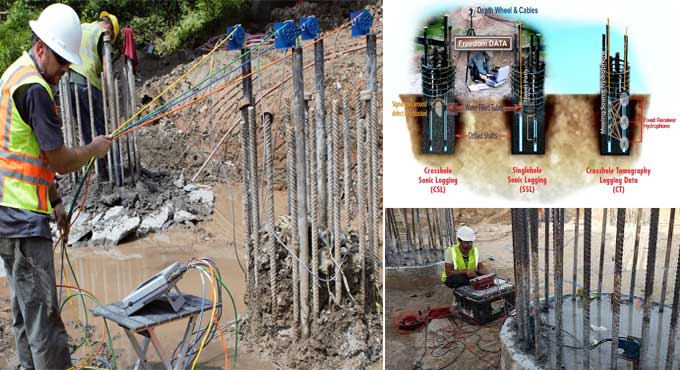
Testing the Foundation Integrity by Cross-Hole Sonic Logging

Among the most accurate methods of evaluating deep foundation, elements are cross-hole sonic logging (CSL). Ultrasonic pulses are transmitted from one probe to another in a pile and based on the received waves, CSL detects the structural integrity. A slurry wall or drilled shaft tests for integrity using it.
Testing CSL ensures that the concrete foundation is sound and is free of defects, such as soil intrusions, sand lenses, or voids. Access tubes (steel or PVC) of 1.5 in diameter typically uses for CSL. As part of the construction, the shaft reinforces with rebar cages are tied to the shaft at the rebar cage level.
Acoustic logging or logging tests are also known as CSLs. Within a few minutes, an anomaly can detect inside the concrete. CSL tests reveal defects whose size, shape, severity, and location can determine by cross-hole tomography (CT), which performs after them. The CSL and CT Analysis are typically used to detect issues associated with problematic concrete pours.
Pile Test Procedure
Access Tube Installation
Prepare the piles before concrete pouring by installing two access tubes. Test tubes are typically made of PVC or steel, and they range in diameter from 38mm to 50mm. An interior rebar cage is attached to the tubes. Then water is poured into them. In determining the number of pipes needed, including the size and resolution of the results must take into account.
Readings Recording
Hydrophones use to take the reading. There are two hydrophones in each tube. A horizontal pulse velocity is measured when the hydrophones lift. By rotating the depth wheel, the reading resolution can adjust. Reading takes usually every six centimeters.
Results
Good-quality concrete propagates ultrasonic waves. An ultrasound wave travels longer and shows lower amplitudes when traveling through poor quality concrete, while a good quality concrete shows a strong response. Concrete voids will completely reduce the signal of the hydrophones when there is a void between them.
Purpose
Slurry walls and drilled shafts are susceptible to several difficulties that could compromise their integrity. These include damage to piles, excessive water intrusion, leaking water from drilled shafts, and damage to reinforcement cages.
After the concrete pour, quality assurance can save considerable time and prevent the discovery of flaws at a later stage. Effective remedial measures can carry out through a proper assessment of the extent of the defect. Slurry walls and drilled shafts provide early indicators of potential problems.
Any structure that can transmit ultrasonic waves can use CSL or CT. The adhesive can use over or below the waterline to cement, grout, and slurry. As well as auger cast piles, the test can conduct on any mass concrete pour is requiring utmost quality assurance.
Benefits
1. An anomaly in a concrete foundation is indicted by determining its size, shape, severity, nature, and location by CSL.
2. The location and identification of multiple defects are carried out.
3. This method is fast and safe. Five minutes are required for the procedure.
4. It is possible to perform CSL tests above and below the waterline.
5. With the test, images with a high degree of accuracy and simplicity are produced.
Applications
Slurry walls and drilled shafts test using sonic cross-hole integrity inspection. You can also conduct this test on auger cast piles to mass concrete pours that need quality assurance.
Cross-hole Tomography
The Cross-hole Tomography (CT) test can use when the CSL method does not provide enough information about the defect size, shape, or nature. Crosshole Tomography picture is taken of the interior of the foundation element To determine the size, shape, and location of the defect.
Wrapping it Up
In terms of concrete or grouted deep foundation elements, cross-hole sonic logging (CSL) is the most efficient and accurate method available. As a quality assurance (QA) technique, cross-hole sonic logging is previously employed in the placement of drilled shafts and auger cast piles but can be effectively used for other applications as well, such as slurry walls and mat foundations.
To learn more, watch the following video tutorial.
Video Source: Geotecnia Brasil
Alternatively, core holes can use if they are available. Sonic logs use for smaller diameter drilled mini-piles and auger cast piles utilizing a variation of this method called Single-Hole Sonic Logging (SSL).
One whole sonic logging analyses concrete quality around an access tube when only a single tube can place in a shaft.


